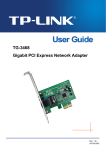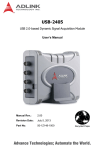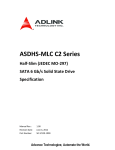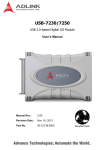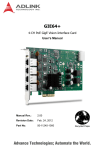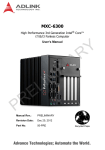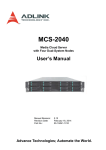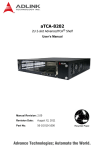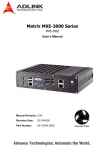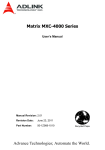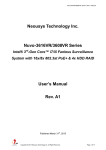Download MXE-5300 Series Manual
Transcript
MXE-5300 Series 5301/5302/5303 Fanless Embedded Computer User’s Manual Manual Rev. 2.00 Revision Date: Dec. 23, 2011 Part No: 50-1Z112-2000 Advance Technologies; Automate the World. Revision History ii Revision Release Date 2.00 Dec. 23, 2011 Description of Change(s) Initial release MXE-5300 Table of Contents Revision History...................................................................... ii List of Tables......................................................................... vii Preface .................................................................................... ix 1 Introduction ........................................................................ 1 1.1 Overview.............................................................................. 1 1.2 Features............................................................................... 2 1.3 Specifications....................................................................... 3 1.4 Unpacking Checklist ............................................................ 4 2 System Description............................................................ 7 2.1 Mechanical Views ................................................................ 7 2.2 Front Panel I/O Connectors ................................................. 9 2.2.1 LED Indicators ............................................................... 10 2.2.2 Power Switch ................................................................. 10 2.2.3 Reset Button .................................................................. 10 2.2.4 PS/2 Connector ............................................................. 10 2.2.5 Dual Gigabit Ethernet Ports ........................................... 11 2.2.6 DVI-I Connector ............................................................. 13 2.2.7 USB 2.0 Connectors ...................................................... 13 2.2.8 USB 3.0 Connectors ...................................................... 14 2.2.9 CFast Slot ...................................................................... 14 2.3 Rear Panel I/O Connectors................................................ 15 2.3.1 DC Power Supply Connector......................................... 15 2.3.2 Dual Gigabit Ethernet Ports ........................................... 16 2.3.3 eSATA Connector.......................................................... 17 2.3.4 Audio Jacks ................................................................... 17 2.3.5 DB-62P COM Port and Digital I/O Connector................ 18 2.4 Internal I/O Connectors...................................................... 21 iii MXE-5300 2.4.1 Clear CMOS and ME RTC Register Jumpers ............... 21 2.4.2 Mini-PCIe Connector ..................................................... 23 2.4.3 DC 5V and 3.3V Connectors for GPS Module............... 24 2.4.4 USIM Port ...................................................................... 24 2.4.5 SATA Connector............................................................ 24 3 Getting Started .................................................................. 25 3.1 Installing a Hard Disk Drive................................................ 25 3.2 Installing Memory............................................................... 29 3.3 Installing CFast Cards........................................................ 32 3.4 COM Ports and DIO Device............................................... 34 3.5 Connecting to DC power.................................................... 36 3.6 Wall-mounting the MXE-5300 ............................................ 37 3.7 Thermal Considerations..................................................... 40 4 Driver Installation.............................................................. 41 4.1 Installing the Chipset Driver ............................................... 41 4.2 Installing the Graphics Driver............................................. 42 4.3 Installing the Ethernet Driver.............................................. 42 4.4 Installing the Audio Driver .................................................. 43 4.5 Installing the WDT Driver ................................................... 43 5 BIOS Settings .................................................................... 45 5.1 Main ................................................................................... 46 5.1.1 BIOS Information ........................................................... 46 5.1.2 System Time/System Date ............................................ 46 5.2 Advanced ........................................................................... 47 5.2.1 ACPI Settings ................................................................ 48 5.2.2 CPU Configuration......................................................... 49 5.2.3 Onboard Device Configuration ...................................... 51 5.2.4 Advanced Power Management...................................... 52 5.2.5 SATA Configuration ....................................................... 54 5.2.6 Intel Anti-Theft Technology Configuration ..................... 55 iv MXE-5300 5.2.7 Intel Anti-Theft Technology............................................ 55 5.2.8 AMT Configuration......................................................... 56 5.2.9 USB Configuration ......................................................... 57 5.2.10Super IO Configuration .................................................. 58 5.2.11H/W Monitor................................................................... 59 5.2.12Serial Port Console Redirection..................................... 60 5.3 Chipset............................................................................... 61 5.3.1 System Agent (SA) Configuration.................................. 62 5.4 Boot ................................................................................... 64 5.4.1 Boot Configuration ......................................................... 64 5.4.2 Boot Option Priorities..................................................... 65 5.5 Security.............................................................................. 65 5.6 Exit..................................................................................... 66 A Appendix: WDT Function Reference ............................... 69 A.1 Watchdog Timer (WDT) Function Reference .................... 69 Important Safety Instructions .............................................. 73 Getting Service...................................................................... 75 v MXE-5300 This page intentionally left blank. vi MXE-5300 List of Tables Table Table Table Table Table Table Table Table Table Table Table Table Table Table 2-1: 2-2: 2-3: 2-4: 2-5: 2-6: 2-7: 2-8: 2-9: 2-10: 2-11: 2-12: 2-13: 5-1: List of Tables MXE-5300 Front Panel Connectors................................. 9 LED Indicators ............................................................... 10 Gigabit Ethernet Port Features ...................................... 11 Active/Link LED ............................................................. 12 Speed LED .................................................................... 12 DVI-I Connector Pin Assignment ................................... 13 Active/Link LED ............................................................. 17 Speed LED .................................................................... 17 DB-62P Connector Pin Assignment............................... 19 D-SUB 9P COM Port Signal Names.............................. 19 Digital I/O Specifications................................................ 20 D-SUB 25P Pin Assignment on Digital I/O port ............. 20 Clear CMOS Jumper ..................................................... 22 Restore On Power Loss................................................. 53 vii MXE-5300 This page intentionally left blank. viii List of Tables MXE-5300 Preface Copyright 2011 ADLINK TECHNOLOGY, INC. This document contains proprietary information protected by copyright. All rights are reserved. No part of this manual may be reproduced by any mechanical, electronic, or other means in any form without prior written permission of the manufacturer. Disclaimer The information in this document is subject to change without prior notice in order to improve reliability, design, and function and does not represent a commitment on the part of the manufacturer. In no event will the manufacturer be liable for direct, indirect, special, incidental, or consequential damages arising out of the use or inability to use the product or documentation, even if advised of the possibility of such damages. Environmental Responsibility ADLINK is committed to fulfill its social responsibility to global environmental preservation through compliance with the European Union's Restriction of Hazardous Substances (RoHS) directive and Waste Electrical and Electronic Equipment (WEEE) directive. Environmental protection is a top priority for ADLINK. We have enforced measures to ensure that our products, manufacturing processes, components, and raw materials have as little impact on the environment as possible. When products are at their end of life, our customers are encouraged to dispose of them in accordance with the product disposal and/or recovery programs prescribed by their nation or company. Trademarks PC, PS/2, and VGA are registered trademarks of International Business Machines Corp. Borland®, Borland® C, C++ Builder®, and Delphi® are registered trademarks of the Borland Software Corporation. LabVIEW™ is a trademark of National Instruments Corporation. Microsoft®, Visual Basic®, Visual C++®, Windows® Preface ix MXE-5300 98, Windows® NT, Windows® 2000, Windows® XP, and Windows® Vista® are registered trademarks of Microsoft® Corporation. PCI™, is a registered trademark of the Peripheral Component Interconnect Special Interest Group (PCI-SIG). Product names mentioned herein are used for identification purposes only and may be trademarks and/or registered trademarks of their respective companies. Conventions Take note of the following conventions used throughout this manual to make sure that users perform certain tasks and instructions properly. Additional information, aids, and tips that help users perform tasks. NOTE: CAUTION: Information to prevent minor physical injury, component damage, data loss, and/or program corruption when trying to complete a task. Information to prevent serious physical injury, component damage, data loss, and/or program corruption when trying to complete a specific task. x Preface MXE-5300 1 Introduction 1.1 Overview The Matrix MXE-5300 series is the latest addition to ADLINK’s Matrix E line, based on the Intel® Core™ i7-2710QE quad-core processor, providing a performance boost of almost 150% with minimal increase in power consumption, and outstanding computing power tailored to a variety of specific application needs. Featuring new simplified system component replacement and maintenance, the MXE-5300 allows effortless access to storage, memory, and wireless modules. Leveraging proprietary mechanical engineering, the MXE-5300 series also retains all the popular features of the Matrix E series, including rugged -20 to 70°C (w/ SSD) fanless operation, 5 Grms vibration resistance, and 9-32V wide range DC input. In addition, the MXE-5300 provides dual mini-PCIe sockets and a USIM socket supporting wireless protocols such as 3G, GPS, WIFI, and Bluetooth. ADLINK’s proprietary wireless enhancement technology empowers the MXE-5300 to deliver industrial-grade wireless performance. The MXE-5300 accommodates Intel® Active Management Technology 7.0, for remote system management, enabling easy maintenance, diagnosis, update, and even BIOS configuration tasks on the MXE-5300 via Ethernet connection. Combing superior processor performance, innovative mechanical design, flexible wireless capability, and rich IO, all in a compact Introduction 1 package, the ADLINK MXE-5300 is an ideal choice for a wide range of applications. 1.2 Features X Intel® Core™ i7-2710QE/i5-2510E/i3-2330E processor + Intel® QM67 chipset X Rugged, up to -20°C to 70°C fanless operation (w/SSD)* X Intel® Active Management Technology 7.0 support X ADLINK proprietary wireless enhancement technology X One onboard SATA-III port X 2 software-programmable RS-232/422/485 (COM1 & COM2), 2 RS-232 X 4 USB 2.0 ports & 2 USB 3.0 ports X Four 1000/100/10 Mbps Ethernet ports (2 Realtek® 8111C + 1 Intel® 82574IT + 1 Intel® 82579 PHY) X One external CFAST socket NOTE: 2 This option guarantees cold boot of the system at -20°c and operation with 100% loading at 70°c. The industrial solid-state drive storage option is required. Introduction MXE-5300 1.3 Specifications MXE-5301 MXE-5302 MXE-5303 Processor Intel® Core™ i7- Intel® Core™ 2710QE i5-2510E Intel® Core™ i3-2330E Chipset Intel® Mobile Platform Controller Hub (QM67) Video VGA+DVI dual display output by DVI-I connector Analog CRT, supports QXGA (2048 x 1536) res. DVI output, supports up to 1920 x 1080 res. Memory 4 GB DDR3 1066 MHz SODIMM module (Up to 8 GB support) System Core I/O Interface Ethernet 4 GbE ports (2 Realtek® 8111C + 1 Intel® 82574IT + 1 82579 PHY) Serial Ports 2 software-programmable RS-232/422/485 (COM1 & COM2) 2 RS-232 (COM3 & COM4) USB 4 USB 2.0 ports & 2 USB 3.0 ports DIO 4 DIO w/ 1.5KV isolation Audio 1 mic-in and 1 speaker-out KB/MS 1 PS/2 keyboard and 1 PS/2 mouse (combo) Mini PCIe 2 internal PCIe mini card sockets USIM 1 USIM socket for 3G communication (used for a 3G-mini module ) WDT Supports watchdog timer Power Supply DC Input Introduction Built-in 9-32 VDC wide-range DC input 3P pluggable connectors with latch (GND, V-, V+) 3 MXE-5301 AC Input MXE-5302 MXE-5303 Optional 160 W external AC-DC adapter for AC input Storage SATA HDD 1 onboard SATA-III port for 2.5" HDD/SSD installation CompactFlash 1 CFAST slot, supporting PIO and DMA modes eSATA 1 eSATA interface connectors on rear panel for storage expansion Mechanical Dimensions 230 mm (W) x 205 mm (D) x 75 mm (H) (9” x 8” x 2.5”) Weight 3.8 kg (8.39 lbs) Mounting Wall-mount kit Environmental Operating Temperature Standard: 0°C to 50°C (w/HDD) Extended Temperature: -20°C to 70°C (w/ industrial SSD or CFAST) Storage Temperature -40°C to 85°C (excl. HDD/SDD/CFAST) Humidity ~95% @ 40°C (non-condensing) Vibration Operating, 5 Grms, 5-500 Hz, 3 axes (w/ CFAST or SSD) Operating, 0.5 Grms, 5-500 Hz, 3 axes (w/ HDD) ESD Contact +/-4 KV and Air +/-8 KV Shock Operating, 50 G, half sine 11 ms duration (w/ CFAST or SSD) EMC CE and FCC Class A 1.4 Unpacking Checklist Before unpacking, check the shipping carton for any damage. If the shipping carton and/or contents are damaged, inform the dealer immediately. Retain the shipping carton and packing mate- 4 Introduction MXE-5300 rials for inspection. Obtain authorization from the dealer before returning any product to ADLINK. Ensure that the following items are included in the package. X MXE-5300 controller X Wall-mount bracket (located in the Accessory Box) X Screw pack for wall-mounting and HDD fixing (located in the Accessory Box) X User’s manual X Com port cable for DB62 to DB9 Introduction 5 This page intentionally left blank. 6 Introduction MXE-5300 2 System Description This section describes the appearance and connectors of the MXE-5300 series, including chassis dimensions, front panel connectors, rear panel connectors, and internal IO connectors. 2.1 Mechanical Views (All dimensions are in mm) NOTE: Figure 2-1: Front View Figure 2-2: Rear View System Description 7 205.2 230 Figure 2-3: Top View 63 75 Figure 2-4: Side View 8 System Description MXE-5300 2.2 Front Panel I/O Connectors This section describes the functions of the MXE-5300 I/O connectors G E D H A F F I A CC B LED Indicators B Power Button C Reset Button D PS/2 keyboard & mouse E Dual Gigabit Ethernet ports F DVI-I connector G USB 2.0 connector x4 (Type A) H USB 3.0 connector x2 (Type A) I CFast connector(Push-Push,Type II) Table 2-1: MXE-5300 Front Panel Connectors System Description 9 2.2.1 LED Indicators In addition to the LED of the power switch, two LEDs on the front panel indicate the following. LED indicator Color Description X If lit continuously, indicates no physical storage is connected Diagnostic Yellow HDD Green X If blinking, indicates no memory is installed on either SODIMM socket When blinking, indicates the SATA hard drive is active Table 2-2: LED Indicators 2.2.2 Power Switch The power switch is non-latched, with a blue LED indicator. System is turned on when the button is depressed, and the power LED lights. If the system hangs, depressing the switch for 5 seconds turns the system off completely. 2.2.3 Reset Button The reset button executes a hard reset. 2.2.4 PS/2 Connector The MXE-5300 provides connectors for PS/2 keyboard and mouse, either singly or with a Y-cable to connect both at the same time. 10 System Description MXE-5300 2.2.5 Dual Gigabit Ethernet Ports The MXE-5300 provides two Gigabit Ethernet ports on the front panel, an Intel® 82574IT Gigabit Ethernet Controller and Intel® 82579LM Gigabit Ethernet PHY, with features as follows. Intel® 82574IT Gigabit Ethernet Controller Intel® 82579LM Gigabit Ethernet PHY Advanced error reporting 802.3x flow control-compliant Message signaled interrupts IEEE 802.1p and 802.1q support TCP segmentation offload/largesend support Energy efficient Ethernet(EEE)802.3az support 802.3x flow control-compliant 10/100/1000 IEEE 802.3-compliant IEEE 802.1p and 802.1q support Automatic MDI/MDIX crossover at all speeds 10/100/1000 IEEE 802.3-compliant Wake-On-LAN feature Automatic MDI/MDIX crossover at all Support Intel® AMT 7.0 speeds ACPI 2.0 specification Reduced power consumption during normal operation and power down modes Wake-On-LAN Preboot eXecution Environment (PXE) flash interface support Fully integrated ASF 2.0 functionality 9 KB jumbo frame support with on-chip μc SMBus 2.0 master interface for ASF Supports LAN Teaming function functionality Preboot eXecution environment (PXE) flash interface support 802.3x flow control-compliant 9 KB jumbo frame support IEEE 802.1p and 802.1q support LAN Teaming Function support Energy Efficient Ethernet(EEE)802.3az support Table 2-3: Gigabit Ethernet Port Features Both Gigabit Ethernet ports provide function indication through LED display, as follows, with a yellow Activity indicator LED on the right side of the port, and a green/orange Speed indicator LED on the left. LED function is the same for both ports System Description 11 . Figure 2-5: Gigabit Ethernet Ports LED Color Yellow Status Description OFF Ethernet port is disconnected. ON Ethernet port is connected with no activity. Flashing Ethernet port is connected and active. Table 2-4: Active/Link LED LED Color Green/ Orange Status Description OFF 10 Mbps Green 100 Mbps Orange 1000 Mbps Table 2-5: Speed LED 12 System Description MXE-5300 2.2.6 DVI-I Connector The MXE-5300 provides one DVI-I connector for external monitor, which can separate to VGA and DVI-D (single link) interfaces. Pin Signal Name Pin Signal Name 1 DVI Data 2- 16 Hot plug detect 2 DVI Data 2+ 17 DVI Data 0- 3 GND 18 DVI Data 0+ 4 CRT DDC clock 19 GND 5 CRT DDC data 20 N/C 6 DVI DDC clock 21 N/C 7 DVI DDC data 22 GND 8 Analog vertical sync 23 DVI clock + 24 DVI clock - 9 DVI Data 1- 10 DVI Data 1+ 11 GND C1 Analog Red 12 N/C C2 Analog Green 13 N/C C3 Analog Blue 14 +5V C4 Analog horizontal sync 15 GND C5 Analog GND Table 2-6: DVI-I Connector Pin Assignment 2.2.7 USB 2.0 Connectors The MXE-5300 provides four Type A USB 2.0 ports on the front panel. All are compatible with Hi-Speed, full-speed, and low-speed USB devices. The MXE-5300 supports multiple boot devices, including USB flash, USB external HD, USB floppy, and USB CD-ROM drives. System Description 13 Boot priority and device can be configured in BIOS. Please refer to Section 6.2.8 USB Configuration for details. 2.2.8 USB 3.0 Connectors The MXE-5300 provides two Type A USB 3.0 ports on the front panel. Based on the TI TUSB7320RKM USB host controller, connection to the host system is achieved through a PCIe x1 Gen2 interface, supporting SuperSpeed, Hi-Speed, full-speed, and lowspeed transmission for the downstream USB 3.0 ports. The MXE-5300 supports multiple boot devices, including USB flash, USB external HD, and USB CD-ROM drives. Boot priority and device can be configured in BIOS. While the USB 3.0 ports allow boot from CD-ROM, OS installation via CD-ROM is not supported. NOTE: 2.2.9 CFast Slot The MXE-5300 is equipped with a type II push-push CFast host connector on the front panel, connecting to the host controller by SATA interface. Data transfer rates up to 3.0Gb/s(300MB/s)/ 1.5Gb/s(150MB/s) are supported. The host SATA controller provides a legacy operating mode using I/O space, and an AHCI operating mode using memory space. The CFast card can function as a storage device for system installation. 14 System Description MXE-5300 2.3 Rear Panel I/O Connectors K L M N O K DC Power Supply Connector L Dual Gigabit Ethernet ports M eSATA Connector N Audio Jacks O DB-62P COM Ports and Digital I/O Connector 2.3.1 DC Power Supply Connector The DC power supply connector of the MXE-5300, on the back panel, consists of V-, chassis ground, and V+ pins, from right to left. V+ and V- pins accept DC power input and the chassis ground pin grounds the chassis for better EMC compatibility. The DC power input of the MXE-5300 allows a voltage input range from 9 VDC to 32 VDC. System Description 15 2.3.2 Dual Gigabit Ethernet Ports The back panel provides two Gigabit Ethernet ports, both on RealTek RTL8111C-VC-GR Gigabit Ethernet Controllers. The RTL8111C-VC-GR supports: X Integrated 10/100/1000 transceiver X Auto-Negotiation with Next Page capability X Supports pair swap/polarity/skew correction X Crossover detection & Auto-Correction X Wake-on-LAN and remote wake-up support X Microsoft® NDIS5, NDIS6 checksum offload and segmentation task-offload support X 802.3x flow control-compliant X Fully compliant with IEEE802.3, IEEE 802.3u, IEEE802.3ab X IEEE 802.1p and 802.1q support X Supports power down/link down power saving X Supports PCI MSI (message signal interrupt) and MSI-X X Supports receive-side scaling (RSS) X Preboot eXecution environment (PXE) flash interface support LEDs on each rear panel LAN port provide the following operational information: 16 System Description MXE-5300 LED Color Status Description Yellow OFF Ethernet port is disconnected. ON Ethernet port is connected and no data transmission. Flashing Ethernet port is connected and transmitting/ receiving data. Table 2-7: Active/Link LED LED Color Status Description Green/ Orange OFF 10 Mbps Green 100 Mbps Orange 1000 Mbps Table 2-8: Speed LED 2.3.3 eSATA Connector One eSATA port connector is located on the back panel, supporting external SATA storage expansion at data transfer rates up to 3.0Gb/s(300MB/s) / 1.5Gb/s(150MB/s). The host SATA controller provides two modes of operation: a legacy mode using I/O space, and an AHCI mode using memory space. This connector supports only SATA singaling, and SATA HDD or SSD requires connection to an external power supply for operation. 2.3.4 Audio Jacks The MXE-5300 implements Intel High Definition audio on a Realtek ALC269 chip. The HD audio supports up to 24-bit, 192 KHz sample rate high quality headphone/speaker output and microphone input. Access is provided by the pink jack for microphone input and the green jack for output. System Description 17 2.3.5 DB-62P COM Port and Digital I/O Connector The MXE-5300 features 4 COM ports and 4-CH isolated digital input and 4channel isolated digital output through a DB-62P connector on the back panel. Also provided is a cable connect to DB62P connector to extend four D-SUB 9-pin connectors and one 25-pin digital I/O connector. The COM1 and COM2 ports selectively support RS-232/ RS-422/ RS-485 mode by BIOS setting, and RS-422/RS-485 mode also provides an optional choice of isolated 1.4 kV capability. The residual COM3 and COM4 ports support RS-232 function only. 18 Pin Signal Name Pin Signal Name Pin Signal Name 1 COM3_TXD 22 43 2 COM3_DTR# 23 COM3_DSR# 44 COM3_RTS# 3 COM3_RI# 24 COM3_DCD# 45 GND 4 COM4_TXD 25 COM4_RXD 46 COM4_CTS# 5 COM4_DTR# 26 COM4_DSR# 47 COM4_RTS# 6 COM4_RI# 27 COM4_DCD# 48 GND 7 COM1_TXD 28 COM1_RXD 49 COM1_CTS# 8 COM1_DTR# 29 COM1_DSR# 50 COM1_RTS# 9 COM1_RI# 30 COM1_DCD# 51 GND 10 COM2_TXD 31 COM2_RXD 52 COM2_CTS# 11 COM2_DTR# 32 COM2_DSR# 53 COM2_RTS# 12 COM2_RI# 33 COM2_DCD# 54 GND 13 EOGND 34 GND 55 EOGND COM3_RXD COM3_CTS# System Description MXE-5300 Pin Signal Name Pin Signal Name Pin Signal Name 14 EOGND 35 IDO_3 56 EOGND 15 EOGND 36 IDO_2 57 EOGND 16 EOGND 37 IDO_1 58 EOGND 17 EOGND 38 IDO_0 59 EOGND 18 IDI_3L 39 IDI_3H 60 +V5DIO_CN_ISO 19 IDI_2L 40 IDI_2H 61 +VDD 20 IDI_1L 41 IDI_1H 62 +VDD 21 IDI_0L 42 IDI_0H Table 2-9: DB-62P Connector Pin Assignment Pin Signal Name RS-232 RS-422 RS-485 1 DCD# TXD422- 485DATA- 2 RXD TXD422+ 485DATA+ 3 TXD RXD422+ N/C 4 DTR# RXD422- N/C 5 GND N/C N/C 6 DSR# N/C N/C 7 RTS# N/C N/C 8 CTS# N/C N/C 9 RI# N/C N/C Table 2-10: D-SUB 9P COM Port Signal Names System Description 19 The onboard digital I/O card supports the following specs: 4-CH Isolated DI 4-CH Isolated DO Logic high: 5 to 24 V Output Type: Open Drain NChannel Power MOSFET driver Logic low: 0 to 1.5 V 250 mA for all channels @60℃, 100% duty Input resistance: 2.4 k @ 0.5 W Supply voltage: 5 to 35 VDC Interrupt source: DI Isolation voltage: 1.5KV DC Isolation voltage: 1.5KV DC channel 0 ~3 Table 2-11: Digital I/O Specifications Pin Signal Name Pin Signal Name Pin Signal Name 1 EOGND 10 IDO_1 19 IDI_3L 2 +V5DIO_CN_ISO 11 EOGND 20 IDI_2H 3 +VDD 12 IDO_0 21 IDI_2L 4 +VDD 13 EOGND 22 IDI_1H 5 EOGND 14 EOGND 23 IDI_1L 6 IDO_3 15 EOGND 24 IDI_0H 7 EOGND 16 EOGND 25 IDI_0L 8 IDO_2 17 EOGND 9 EOGND 18 IDI_3H Table 2-12: D-SUB 25P Pin Assignment on Digital I/O port Legend: 20 X IDO_n: Isolated digital output channel #n. X IDI_nH: High input of isolated differential DI channel #n. X IDI_nL: Low input of isolated differential DI channel #n. X EOGND: Ground return path of isolated output channels. X VDD: Power input signal for fly-wheel diode of DO channels. System Description MXE-5300 2.4 Internal I/O Connectors Figure 2-6: Mainboard Top View (showing Clear CMOS and ME RTC Register Jumpers) 2.4.1 Clear CMOS and ME RTC Register Jumpers Under abnormal conditions in which the MXE-5300 controller fails to boot, clearing the BIOS content stored in CMOS and restoring the default settings may be effective. To clear CMOS, shorten System Description 21 Pin#1 and Pin#2 of JP1 and remove the jumper, after which the CMOS will be restored to factory default settings. Normal Clear Table 2-13: Clear CMOS Jumper CAUTION: 22 As with JP1, shorting Pin#1 and #2 of JP2 will clear the ME RTC register, however, since this jumper is used by RMA, user clearance of the ME RTC register may cause unexpected errors in system behavior. System Description MXE-5300 B A C D Figure 2-7: Mainboard Underside View A Mini-PCIe Connectors (Default: Rev.1.2, Option: Rev.1.1) B DC 5V and 3.3V Connectors for GPS Module C USIM Port D SATA Connectors 2.4.2 Mini-PCIe Connector Mini-PCIe connectors provide function expansion by enabling installation of a third party Mini-PCIe module such as a WiFi module, 3.5G module, or other. System Description 23 2.4.3 DC 5V and 3.3V Connectors for GPS Module Two power connectors are provided for GPS module use, one 5V and the other 3.3V, with maximum current rating of each 1A. 2.4.4 USIM Port Use of a 3.5G mini-PCIe module normally requires a SIM card to support communication with a telecom operator. The MXE-5300 provides a USIM port connected to mini-PCIe connector. The SIM card and 3.5G mini-PCIe module can be installed to facilitate 3.5G communication. 2.4.5 SATA Connector Two SATA connectors support data transfer up to 6.0Gb/s(600MB/ s). The SATA host controller supports a legacy mode using I/O space and AHCI mode using memory space. The SATA connector is compatible with a 2.5 in hard disk drive (HDD) or solid state disk (SSD). The HDD or SSD must be installed into the SATA connector with a HDD bracket. 24 System Description MXE-5300 3 Getting Started This chapter discusses installation of hard disk drive, memory, and CFast card. In addition to connection and use of DIO and COM ports, wall-mount installation is also described. 3.1 Installing a Hard Disk Drive Before installing a hard disk drive, remove the bottom cover of the chassis as follows. 1. Remove the thumbscrews on the front panel by hand or a screwdriver. 2. Withdraw the thumbscrews and remove the bottom cover by pulling and lifting. Getting Started 25 3. Remove the mounting screw from the top of the HDD bracket. 26 Getting Started MXE-5300 4. Pull and lift the HDD bracket. 5. Use the 4 included M3-F head screws to fix one 2.5” HDD or SSD to the bracket. Getting Started 27 6. Install the 2.5’’ HDD or SSD to the SATA connector. 7. Reassemble the chassis. 28 Getting Started MXE-5300 3.2 Installing Memory Before installing RAM, the bottom cover must be removed, as described in steps 1 and 2 of Section 3.1. 1. Remove 3 M3-P head screws from the top of the RAM bracket. 2. Remove 2 M3-F head screws from the front panel. Getting Started 29 3. Pull and lift the RAM bracket. 4. Insert DDRIII SODIMM RAM into the slot at an angle. 30 Getting Started MXE-5300 5. Depress RAM until the latch catches and RAM is securely fixed. Getting Started 31 3.3 Installing CFast Cards The MXE-5300 series provides an external CFast socket to accommodate one CFast card, acting as a replacement of the hard disk drive. 1. Remove and rotate the CFast cover to expose the slot . 2. Gently insert the CFast card into the CFast socket. 32 Getting Started MXE-5300 3. Rotate the CFast cover to its orginal position and replace. Getting Started 33 3.4 COM Ports and DIO Device The MXE-5300 series controller integrates 4 COM ports and 4 digital input and 4 digital output ports into a connector, The included breakout cable can connect COM ports and the DIO device. 1. Connect the cable to the connector on the rear panel . 34 Getting Started MXE-5300 2. The 4 COM ports cables are numbered 1 to 4, with 1 and 2 connecting to RS-232 interface devices and 3 and 4 to RS-422 or RS-485 interface devices. 3. The DIO cable connects to a terminal board for digital input and output. Getting Started 35 3.5 Connecting to DC power Before introducing DC power to the MXE-5300 controller, ensure the voltage and polarity provided are compatible with the DC input. Improper input voltage and/or polarity can be responsible for system damage The DC power input connector of the MXE-5300 utilizes V+, V-, and chassis ground pins, and accepts input voltage as shown previously. 1. Connect the DC power as shown 2. Fix the DC connector using the 2 screws. 36 Getting Started MXE-5300 3.6 Wall-mounting the MXE-5300 The MXE-5300 controller is shipped with wall-mount brackets and accessory screws, with mounting procedures as follows. 1. Prepare the two wall-mount brackets and 4 M4-P head screws included in the package. Getting Started 37 2. Remove the 4 plastic pads from the corners of the chassis underside. 3. With the 4 included M4-P head screws, fix the 2 wallmount brackets, also included, to the chassis, according to the spacing dimensions of the screw holes and brackets, as shown. 38 Getting Started MXE-5300 Getting Started 39 4. Once final assembly as shown is complete, mount the MXE-5300 series controller on the wall via the screw holes. 3.7 Thermal Considerations Heat-generating components of the MXE-5300 (such as CPU and PCH) are all situated on the left side of the system. These components directly contact the heat sink via thermal pads and dissipate heat generated by the components. To maximize efficiency of heat dissipation, a minimum of 2 inches (5 cm) clearance should be maintained on the top of the chassis. 40 Getting Started MXE-5300 4 Driver Installation This section describes the drivers needed for Windows operating systems and the procedures to install them. For other OS support, please contact ADLINK for further information. Properly install Windows before installing any drivers. Most standard I/O device drivers have been included in Windows. The following drivers must be installed: X Chipset X Graphics X Ethernet X WDT (watchdog timer) 4.1 Installing the Chipset Driver The chipset driver directs the operating system in configuration of the Intel® QM67 chipset components to guarantee performance of: X Core PCI and ISAPNP Services X PCIe Support X SATA Storage Support X USB Support X Identification of Intel® Chipset Components in the Device Manager One of the following operating systems must be fully installed and running on the system before installing this software: X Microsoft Windows XP X Microsoft windows 7 To install the chipset driver for the MXE-5300 : 1. Close any running applications. 2. Insert the ADLINK All-in-One DVD; the chipset driver is located in the directory: x:\Driver Installa- Driver Installation 41 tion\Matrix\MXE-5300\Chipset\ (where x: denotes the DVD-ROM drive) 3. Execute Setup.exe and follow the onscreen instructions to complete the setup. 4. After installation is complete, reboot the system. 4.2 Installing the Graphics Driver The MXE-5300 is equipped with the Intel® HD Graphic 3000 graphics media accelerator integrated in Intel Mobile Intel® ATOM. The Intel® Graphics Media Accelerator Driver package supports Windows 7 and Windows XP. To install the graphics driver. 1. Close any running applications. 2. Insert the ADLINK All-in-One DVD; the graphics driver is located in the directory: x:\Driver Installation\Matrix\MXE-5300\Graphics\ (where x: denotes the DVD-ROM drive). 3. Execute Setup.exe and follow the onscreen instructions to complete the setup. 4. After installation is complete, reboot the system. 4.3 Installing the Ethernet Driver To install the driver for Realtek 8111C Gigabit Ethernet controller, for Windows 7 and XP users: 1. Close any running applications. 2. Insert the ADLINK All-in-One DVD; the Ethernet driver is located in the directory: x:\Driver Installation\Matrix\MXE-5300\LAN-Realtek\ (where x: denotes the DVD-ROM drive). 3. Execute Setup.exe and follow the onscreen instructions to complete the setup. 4. After installation is complete, reboot the system. 42 Driver Installation MXE-5300 To install the driver for Intel 82547 Gigabit Ethernet controller, for Windows 7 and XP users: 1. Close any running applications. 2. Insert the ADLINK All-in-One DVD; the Ethernet driver is located in the directory: x:\Driver Installation\Matrix\MXE-5300\LAN-Intel\ (where x: denotes the DVD-ROM drive). 3. Execute Setup.exe and follow the onscreen instructions to complete the setup. 4. After installation is complete, reboot the system. 4.4 Installing the Audio Driver The MXE-5300 supports Intel High Definition audio using Realtek ALC269 audio codec. To install the audio driver for MXE-5300, for Windows 7, XP, and Vista users: 1. Close any running applications. 2. Insert the ADLINK All-in-One DVD; the audio driver is located in the directory:x:\Driver Installation\Matrix\MXE5300\Audio\ (where x: denotes the DVD-ROM drive). 3. Execute Setup.exe and follow the onscreen instructions to complete the setup. 4. After installation is complete, reboot the system. 4.5 Installing the WDT Driver A WDT (watchdog timer) is a hardware mechanism resetting the system when the operating system or application is halted. A typical usage of WDT is to start and periodically reset timers, and when a timer is expired, the system resets. To install the WDT driver for the MXE-5300: 1. Close any running applications. 2. Insert the ADLINK All-in-One DVD; the WDT driver is located in the directory: x:\Driver Installa- Driver Installation 43 tion\Matrix\MXE-5300\WDT\ (where x: denotes the DVDROM drive). 3. Execute Setup.exe and follow the onscreen instructions to complete the setup. 4. After installation is complete, reboot the system. 44 Driver Installation MXE-5300 5 BIOS Settings The Basic Input/Output System (BIOS) is a program that provides a basic level of communication between the processor and peripherals. In addition, the BIOS also contains codes for various advanced features applied to the MXE-5300. The BIOS setup program includes menus for configuring settings and enabling features of MXE-5300. Most users do not need to use the BIOS setup program, as the MXE-5300 controller ships with default settings that work well for most configurations. NOTE: CAUTION: BIOS options in the manual are for reference only. Different configurations may lead to actual BIOS displayed differing from that shown here. Users are welcome to download the latest BIOS version from our website. Changing BIOS settings may lead to incorrect controller behavior and possible inability to boot. In such a case, see Section 2.4.1: Clear CMOS and ME RTC Register Jumpers for instruction on clearing the CMOS and restoring default settings. BIOS Settings 45 5.1 Main 5.1.1 BIOS Information Shows current system BIOS code version and BIOS version. 5.1.2 System Time/System Date Use this option to change the system time and date. Highlight System Time or System Date using the up or down <Arrow> keys. Enter new values using the keyboard then <Enter>. Enter < Tab > to move between fields. The date must be entered in MM/DD/YY format. The time is entered in HH:MM:SS format. The time is in 24-hour format. For example, 5:30 A.M. appears as 05:30:00, and 5:30 P.M. as 17:30:00. NOTE: 46 BIOS Settings MXE-5300 5.2 Advanced Setting incorrect or conflicting values in Advanced BIOS Setup may cause system malfunctions. CAUTION: BIOS Settings 47 5.2.1 ACPI Settings Enable ACPI Auto Configuration Enables or disables BIOS ACPI Auto Configuration. Enable Hibernation Enables or disables system's ability to hibernate. This option may be not effective with some OS. ACPI Sleep State Selects the highest ACPI sleep state the system will enter when the SUSPEND button is pressed. Lock Legacy Resource Enables or disables lock of legacy resource to prevent changes in IO resource for legacy devices like serial ports. 48 BIOS Settings MXE-5300 5.2.2 CPU Configuration Limit CPUID Maximum Disabled for Windows XP. Execute Disable Bit Enables XD to prevent certain classes of malicious buffer overflow attacks when combined with a supporting OS. Hardware Prefetcher Enables or disables the Mid Level Cache (L2) streamer prefetcher. Adjacent Cache Line Prefetch Enables or disables the prefetching of adjacent cache lines. BIOS Settings 49 Intel Virtualization Technology When enabled, a VMM can utilize the additional hardware capabilities provided by Vanderpool Technology. Local x2APIC Enables Local x2APIC, some OS do not support this. EIST Enables/disables Intel SpeedStep Technology. Turbo Mode Enables/disables Intel TurboBoost Technology. C1E Function When enabled, lets CPU enter enhanced C1 sleep state to save more power than C1. CPU C3 Support Enables/disables CPU C3(ACPI C2) report to OS. CPU C6 Support Enables/disables CPU C6(ACPI C3) report to OS. CPU C7 Support Enables/disables CPU C7(ACPI C3) report to OS. 50 BIOS Settings MXE-5300 5.2.3 Onboard Device Configuration Intel 82579LM LAN Enables/disables onboard Intel 82579LM (built-in PCH) LAN controller. Launch Intel 82579LM LAN PXE OpROM Enables or disables execution of LAN boot-rom to add boot option for legacy network devices. Intel 82574 LAN Enables/disables onboard Intel 82574 LAN controller. Launch Intel 82574 LAN PXE OpROM Enables or disables execution of LAN boot-rom to add boot option for legacy network devices. RealTek 8111C LAN #1 (Appear on MXE5300 only) Enables/disables onboard RealTek 8111C LAN controller. BIOS Settings 51 Launch RealTek 8111C PXE OpROM Enables or disables execution of LAN boot-rom to add boot option for legacy network devices. RealTek 8111C LAN #2 (Appear on MXE5300 only) Enables/disables onboard RealTek 8111C LAN controller. Launch RealTek 8111C PXE OpROM Enables or disables execution of LAN boot-rom to add boot option for legacy network devices. 5.2.4 52 Advanced Power Management BIOS Settings MXE-5300 Restore On AC Power Loss Determines the state the computer enters when power is restored after a power loss. Options for this value are Last State, Power On and Power Off. Option Description Power Off When set, powers the system down when power is restored. Power On When set, powers the system on when power is restored. Last State When set, powers the system down or on depending on the last system power state when power is restored. Table 5-1: Restore On Power Loss Wake up system by 82579L LAN in S5 Enables or disables integrated LAN to wake the system in S5 state. RTC Wakeup in S5 Enables or disables system wake on alarm event. System watchdog Enables or disables system internal watchdog to prevent boot failure during system POST stage. BIOS Settings 53 5.2.5 SATA Configuration SATA Controller(s) Enables/disables internal serial ATA controller SATA Mode Selection This option selects the SATA channel configuration from among (1) IDE Mode or (2) AHCI Mode Serial ATA Port 0 / C-Fast Port / E-SATA Port Port X Enables or disables SATA Port X Hot Plug Sets this port as hot pluggable. 54 BIOS Settings MXE-5300 5.2.6 Intel Anti-Theft Technology Configuration 5.2.7 Intel Anti-Theft Technology Enables or disables Intel AT function. Intel® Anti-Theft Technology helps stop theft by making computers non-functional with immediate shutdown. Intel Anti-Theft Technology Recovery/Enter Intel AT suspend mode Miscellaneous settings for Intel AT function. BIOS Settings 55 5.2.8 AMT Configuration Intel AMT Enables/disables Intel AMT function. Intel AMT Setup Prompt Enables/disables launching of MEBx during system post for configuring AMT features. BIOS Hotkey Pressed/MEBx Selection Screen Miscellaneous settings for iAMT function. 56 BIOS Settings MXE-5300 5.2.9 USB Configuration Legacy USB Support AUTO option disables legacy support if no USB devices are connected, DISABLE option keeps USB devices available only for EFI applications. USB3.0 Support Enables or disables USB3.0 (XHCI) controller support, allowing USB 3.0 devices to be used in DOS environment. XHCI Hand-Off Enables BIOS support of XHCI Hand-Off feature. Default option is Enabled. EHCI Hand-Off Enables BIOS support of EHCI Hand-Off feature. Default option is Enabled. BIOS Settings 57 5.2.10 Super IO Configuration Serial Port 1 to 4 Configuration Can enable/disable the port, select port type (RS-232/422/485) for Serial Port 1 and 2 only, or change the port settings (address). 58 BIOS Settings MXE-5300 5.2.11 H/W Monitor PC Health Status The hardware health on Super I/O supports Board Temperature 1/2, CPU Temperature, CPU Voltage, I-GFX Voltage, VCCSA Voltage, +1.05V, +3.3V, +1.5V, +5V, +12.0V, and VBAT. BIOS Settings 59 5.2.12 Serial Port Console Redirection COM 1 to 4, SOL (Serial Over LAN) COM Console Redirection Enables console redirection of COM 1 to 4, SOL COM. Console Redirection Settings Miscellaneous parameters for COM Port 1 to 4, SOL COM. Serial Port for Out-of-Band Management/EMS Console Redirection Enables console redirection for remote management of a Windows Server OS through the port selected by Outof-Band Mgmt Port. 60 BIOS Settings MXE-5300 Out-of-Band Mgmt Port Selects the COM Port for remote management of a Windows OS. Terminal Type Selects the transmission protocol for remote terminal console. 5.3 Chipset BIOS Settings 61 5.3.1 System Agent (SA) Configuration VT-d Enables VT-d function for efficient virtualization of I/O devices. Graphics Configuration Selects internal graphic device shared memory size and power policy. 62 BIOS Settings MXE-5300 Graphics Turbo IMON Current Sets the maximum IMON current value for graphics turbo mode. GTT Size Selects GTT size for internal graphics. DVMT Pre-Allocated Selects DVMT 5.0 pre-allocated graphics memory size used by the internal graphics device. DVMT Total Gfx Memory Selects DVMT 5.0 total graphics memory size used by the internal graphics device. BIOS Settings 63 5.4 Boot 5.4.1 Boot Configuration Setup Prompt Timeout Number of seconds to wait for setup activation key (DEL). Bootup Num-Lock State Allows Number Lock setting to be modified during boot. Quiet Boot When Disabled, directs BIOS to display POST messages; when Enabled, directs BIOS to display the OEM logo. 64 BIOS Settings MXE-5300 5.4.2 Boot Option Priorities Specifies the priority of boot devices, with all installed boot devices detected during POST and displayed, selecting Boot Option # specifies the desired boot device. 5.5 Security If only the Administrator’s password is set, only access to Setup is limited and is only requested when entering Setup. If only the user’s password is set, power on requires a password which must be entered to boot or enter setup. In Setup the user has Administrator rights. Administrator Password Sets Administrator password BIOS Settings 65 User Password Sets boot/setup User password 5.6 Exit Save Changes and Exit When BIOS settings are complete, selecting this option saves all changes and reboots the system, and new settings take effect. Discard Changes and Exit Discards all changes and exits BIOS setup. Discard Changes and Reset Resets system setup without saving any changes. 66 BIOS Settings MXE-5300 Restore Defaults Returns all BIOS options to Default settings, designed for maximum system stability, but not performance. Applicable in the event of system configuration problems. Launch EFI Shell from filesystem device Attempts to launch EFI Shell application (Shellx64.efi) from one of the available filesystem devices. BIOS Settings 67 This page intentionally left blank. 68 BIOS Settings MXE-5300 Appendix A WDT Function Reference A.1 Watchdog Timer (WDT) Function Reference This appendix describes the usage of the watchdog timer (WDT) function library for the MXE-5300 controller. Watchdog timer is a hardware mechanism to reset the system in case the operating system or an application halts. After starting watchdog timer, you need to periodically reset the watchdog timer in the application before the timer expires. Once watchdog timer expires, a hardware-generated signal is sent to reset the system. To use the WDT function library for MXE-5300, you need to include the header file WDT.h and linkage library WDT.lib in your C++ project. InitWDT Description Initializes the watchdog timer function of MXE-5300 controller. InitWDT must be called before the invocation of any other WDT function. Supported controllers MXE-5300 Syntax C/C++ BOOL InitWDT() Parameters None Return code TRUE if watchdog timer is successfully initialized. FALSE if watchdog timer is failed to initialize. WDT Function Reference 69 MXE-5300 SetWDT Description Set the timeout value of watchdog timer. There are two parameters for this function to indicate the timeout ticks and unit. Users should call ResetWDT or StopWDT before the expiration of watchdog timer, or the system will be reset. Supported controllers MXE-5300 Syntax C/C++ BOOL SetWDT(BYTE tick, BYTE unit) Parameters tick Specify the number of tick for watchdog timer. A valid value is 1 - 255. unit Specify the timeout ticks of the watchdog timer. Value Description 0 The unit of tick is second. For example, when you specify tick as 100 and unit as 0, the timeout value is 100 seconds. 1 The unit of tick is minute. For example, when you specify tick as 100 and unit as 1, the timeout value is 100 minutes. Return codes TRUE if timeout value of watchdog timer is successfully set. FALSE if timeout value of watchdog timer is failed to set. 70 WDT Function Reference MXE-5300 StartWDT Description Start the watchdog timer function. Once the StartWDT is invoked, the countdown of watchdog timer starts. Users should call ResetWDT or StopWDT before the expiration of watchdog timer, or the system will be reset. Supported controllers MXE-5300 Syntax C/C++ BOOL StartWDT() Parameters None Return codes TRUE if watchdog timer is successfully started. FALSE if watchdog timer is failed to start. ResetWDT Description Reset the watchdog timer. The invocation of ResetWDT allows users to restore the watchdog timer to the initial timeout value specified in SetWDT function. Users should call ResetWDT or StopWDT before the expiration of watchdog timer, or the system will be reset. Supported controllers MXE-5300 Syntax C/C++ BOOL ResetWDT() Parameters None WDT Function Reference 71 MXE-5300 Return codes TRUE if watchdog timer is successfully reset. FALSE if watchdog timer is failed to reset. StopWDT Description Stop the watchdog timer. Supported controllers MXE-5300 Syntax C/C++ BOOL StopWDT() Parameters None Return codes TRUE if watchdog timer is successfully stopped. FALSE if watchdog timer is failed to stop. 72 WDT Function Reference PXIe-3975 Important Safety Instructions For user safety, please read and follow all instructions, WARNINGS, CAUTIONS, and NOTES marked in this manual and on the associated equipment before handling/operating the equipment. X Read these safety instructions carefully. X Keep this user’s manual for future reference. X Read the specifications section of this manual for detailed information on the operating environment of this equipment. X When installing/mounting or uninstalling/removing equipment: Z X Turn off power and unplug any power cords/cables. To avoid electrical shock and/or damage to equipment: Z Keep equipment away from water or liquid sources; Z Keep equipment away from high heat or high humidity; Z Keep equipment properly ventilated (do not block or cover ventilation openings); Z Make sure to use recommended voltage and power source settings; Z Always install and operate equipment near an easily accessible electrical socket-outlet; Z Secure the power cord (do not place any object on/over the power cord); Z Only install/attach and operate equipment on stable surfaces and/or recommended mountings; and, Z If the equipment will not be used for long periods of time, turn off and unplug the equipment from its power source. Important Safety Instructions 73 X Never attempt to fix the equipment. Equipment should only be serviced by qualified personnel. X A Lithium-type battery may be provided for uninterrupted, backup or emergency power. Risk of explosion if battery is replaced with an incorrect type; please dispose of used batteries appropriately. X 74 Equipment must be serviced by authorized technicians when: Z The power cord or plug is damaged; Z Liquid has penetrated the equipment; Z It has been exposed to high humidity/moisture; Z It is not functioning or does not function according to the user’s manual; Z It has been dropped and/or damaged; and/or, Z It has an obvious sign of breakage. Important Safety Instructions MXE-5300 Getting Service Contact us should you require any service or assistance. ADLINK Technology, Inc. Address: 9F, No.166 Jian Yi Road, Zhonghe District New Taipei City 235, Taiwan ᄅؑקխࡉ৬ԫሁ 166 ᇆ 9 ᑔ Tel: +886-2-8226-5877 Fax: +886-2-8226-5717 Email: [email protected] Ampro ADLINK Technology, Inc. Address: 5215 Hellyer Avenue, #110, San Jose, CA 95138, USA Tel: +1-408-360-0200 Toll Free: +1-800-966-5200 (USA only) Fax: +1-408-360-0222 Email: [email protected] ADLINK Technology (China) Co., Ltd. Address: Ϟ⍋Ꮦ⌺ϰᮄऎᓴ∳催⾥ᡔುऎ㢇䏃 300 ো(201203) 300 Fang Chun Rd., Zhangjiang Hi-Tech Park, Pudong New Area, Shanghai, 201203 China Tel: +86-21-5132-8988 Fax: +86-21-5132-3588 Email: [email protected] ADLINK Technology Beijing Address: ࣫ҀᏖ⍋⎔ऎϞഄϰ䏃 1 োⲜ߯ࡼॺ E ᑻ 801 ᅸ(100085) Rm. 801, Power Creative E, No. 1, B/D Shang Di East Rd., Beijing, 100085 China Tel: +86-10-5885-8666 Fax: +86-10-5885-8625 Email: [email protected] ADLINK Technology Shenzhen Address: ⏅ഇᏖफቅऎ⾥ᡔುफऎ催ᮄफϗ䘧᭄ᄫᡔᴃು A1 ᷟ 2 ὐ C ऎ (518057) 2F, C Block, Bldg. A1, Cyber-Tech Zone, Gao Xin Ave. Sec. 7, High-Tech Industrial Park S., Shenzhen, 518054 China Tel: +86-755-2643-4858 Fax: +86-755-2664-6353 Email: [email protected] ADLINK Technology (Europe) GmbH Address: Nord Carree 3, 40477 Duesseldorf, Germany Tel: +49-211-495-5552 Fax: +49-211-495-5557 Email: [email protected] Getting Service 75 MXE-5300 ADLINK Technology, Inc. (French Liaison Office) Address: 15 rue Emile Baudot, 91300 Massy CEDEX, France Tel: +33 (0) 1 60 12 35 66 Fax: +33 (0) 1 60 12 35 66 Email: [email protected] ADLINK Technology Japan Corporation Address: ͱ101-0045 ᵅҀ䛑गҷ⬄ऎ⼲⬄䤯 ⬎ފ3-7-4 ⼲⬄ 374 ɛɳ 4F KANDA374 Bldg. 4F, 3-7-4 Kanda Kajicho, Chiyoda-ku, Tokyo 101-0045, Japan Tel: +81-3-4455-3722 Fax: +81-3-5209-6013 Email: [email protected] ADLINK Technology, Inc. (Korean Liaison Office) Address: 昢殾柢 昢爎割 昢爎壟 1675-12 微汾瘶捒娯 8 猻 8F Mointer B/D,1675-12, Seocho-Dong, Seocho-Gu, Seoul 137-070, Korea Tel: +82-2-2057-0565 Fax: +82-2-2057-0563 Email: [email protected] ADLINK Technology Singapore Pte. Ltd. Address: 84 Genting Lane #07-02A, Cityneon Design Centre, Singapore 349584 Tel: +65-6844-2261 Fax: +65-6844-2263 Email: [email protected] ADLINK Technology Singapore Pte. Ltd. (Indian Liaison Office) Address: 1st Floor, #50-56 (Between 16th/17th Cross) Margosa Plaza, Margosa Main Road, Malleswaram, Bangalore-560055, India Tel: +91-80-65605817, +91-80-42246107 Fax: +91-80-23464606 Email: [email protected] ADLINK Technology, Inc. (Israeli Liaison Office) Address: 6 Hasadna St., Kfar Saba 44424, Israel Tel: +972-9-7446541 Fax: +972-9-7446542 Email: [email protected] 76 Getting Service






















































































